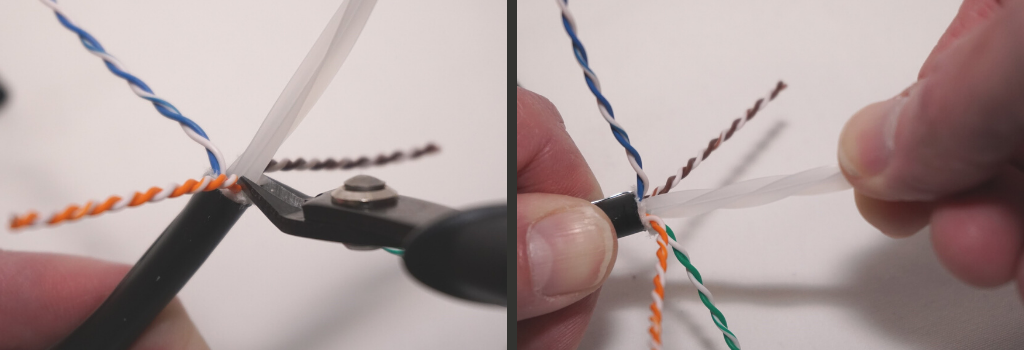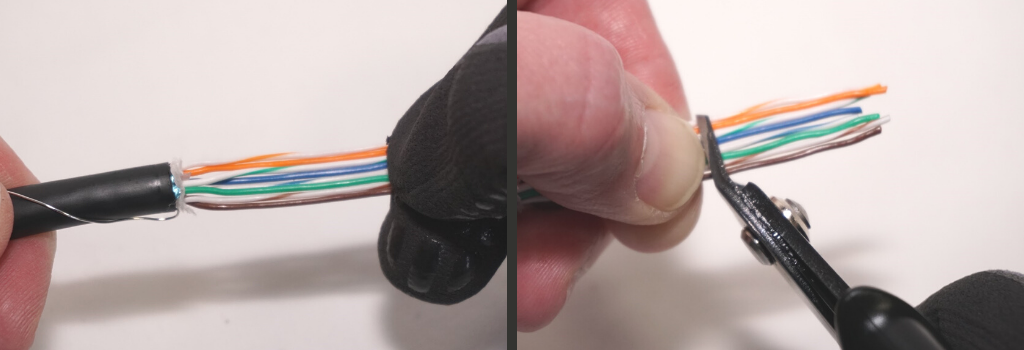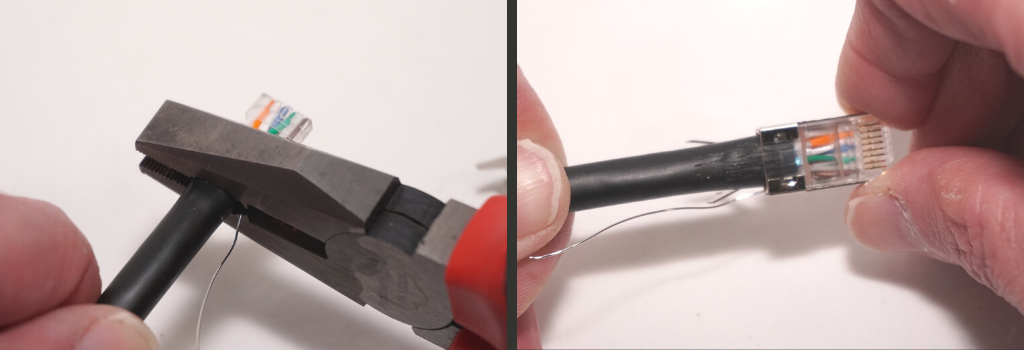Is It Easy to Terminate Cat 6 Cable
How To: Terminate a Shielded Cat6/Cat6A Standard Load Bar RJ45 Connector With External Ground
Written by Don Schultz, trueCABLE Technical Sales Representative & Fluke Networks Certified Technician
Just bought yourself a nice outdoor surveillance camera or Wi-Fi Access Point? You have to hook that thing up somehow, and the only way is to attach a RJ45 plug to the end of an Ethernet cable. But...how? There is a lot of confusion and misinformation out there regarding the termination of shielded bulk Ethernet cable to shielded plugs. Horror stories abound about how difficult it is. Actually, it is not that difficult once you know how to do it and what to buy. Welcome to the right path! Let's take a dive into this process, where I will show you how to do it correctly.
What We Are Covering
When talking about RJ45 plugs, there is quite a variety. This blog focuses on Cat6 and Cat6A as they are similar enough to address at once. Here is the scenario:
- trueCABLE shielded (F/UTP) Cat6 Outdoor CMX Direct Burial solid copper Ethernet cable.
- Cat6 or Cat6A shielded standard RJ45 connectors with external ground.
You bought both, and need to get the plug onto the cable.
RJ45's or 8P8C connectors are referred to as plugs, ends, and more. They all mean the same thing.
How did I know that the cable in question would work with this plug? I knew how to Select the Correct Connector.
Notes on Cat6 and Cat6A Shielded plugs in general:
-
Wire conductors are typically "staggered" four high and four low
-
The reason for this design is physical compatibility. The size of the RJ45 plug on the outside is limited according to ANSI/TIA specifications, but shielded cable (Cat6 or Cat6A) wire thickness is often very thick. If all the conductors were placed eight across like unshielded Cat6 or Cat5e plugs, there would be no room for them.
-
The bonus benefit of staggering conductors is reduction of crosstalk. As Ethernet cable frequency exceeds 350 MHz, crosstalk starts to become an issue of particular concern. All the better if the plug's physical design also reduces the crosstalk phenomenon.
-
Most of these shielded plugs cannot be terminated with a standard crimp tool. The reason has to do with the lack of a strain latch built into the plug. This plastic latch, found near the rear of most RJ45 plugs, is pressed into the cable jacket during the crimping/termination process and prevents the cable from being pulled out by accident. Thick shielded cable, and especially thick outdoor shielded cable, is so large that there is no room for that strain latch. Unfortunately, most standard RJ45 crimp tools have a strain latch presser bar. That presser bar would crush the shielded RJ45 plug since there is no rectangular cut-out for it. This means you need a termination tool that lacks (or has the ability to disengage) the strain latch presser bar. That tool is shown in this blog.
-
To accept the largest outer diameter shielded cables, Cat6 and Cat6A shielded plugs typically have an external ground tab. This is where the drain wire will contact the metal of the ground tab to ground the plug to the cable electrically.
Tools Needed
You will need the following:
- RJ45 termination tool with no strain latch presser bar (or in this case, one that can adjust to stop it from engaging)
- Cable cutter and stripper
- Flush cutter
Additional tools I recommend and likely you have around the house:

Light gloves, electrical lineman's pliers, and a screwdriver will be of great help!
You will need the electrical lineman's pliers for thick shielded Ethernet cables. They will allow for "ovalization". A screwdriver?! Yup. The smooth shaft will be used to straighten out conductors, while you are wearing the glove. This will save your fingers, trust me.
Are You an A or B?
The next step is deciding whether you want to use the T568A or T568B pattern. It does not matter which one you pick, as long as you stick with it. I prefer the "B" pattern, but that is just me.

Gather Up the Tools, Here We Go!
From here on out, I'll let the pictures speak for themselves with a bit of additional guidance.
Step 1:
Adjust the cutting blade of the cable stripper so that it only makes contact with the cable jacket. This takes practice, and you may have to repeat this step a few times to get the perfect score on the jacket. Don't cut through it...score it. If you cut through, you likely nicked a conductor and you should cut off the end and start over.

Strip off about 2.5" of cable jacket. Use the adjustable knob to achieve the perfect score on the cable jacket. Then t urn the tool two to three times completely around to score.
Step 2:
Once the cable jacket is scored, bend it back and forth a few times to "pop" the jacket. Keep the hollow piece of the jacket--it is your new free tool.

Scored cable jacket.
Step 3:
Remove any ripcord, PE tape, or waterproof tape all the way down to the end of the cable jacket using flush cutters. Be careful not to nick any conductors while doing this.

Cut the ripcord.
Step 4:
Remove the cable shield carefully, followed by the waterproof tape - it may take several cuts. Don't accidentally cut off the drain wire.

Carefully nip the foil shield right at the end of the jacket and remove it. Fold the drain wire back to keep it out of the way. Removal of the waterproof tape will require flush cutters.
Step 5:
Place the conductor pairs into a "star" pattern, at a 90-degree angle to the cable jacket as shown.

Foil and waterproof tape removed. Get it as "clean" as possible at the jacket end and place conductor in "star pattern."
Step 6:
At a slight downward angle, cut each "wing" of the spline (plastic cross skeleton) using flush cutters. Make four cuts, but don't cut the spline straight across. Be extremely careful to not nick a conductor in this process. The idea is to remove the spline so that it is as even as possible with the top of the jacket.
Once the spline wings are cut, twist the spline to remove it.

The more spline that protrudes the more difficulty you will have with fully seating the RJ45 plug. Once you cut the spline wings, then twist to remove.
Step 7:
Use your free tool to untwist the conductors. Untwist each pair downward towards the cable jacket.

All pairs untwisted
Step 8:
Now that all the pairs have been untwisted, it is time to put the glove on and use the screwdriver to remove kinks from the conductors. You want the conductors as straight as possible, and it may take two to three passes from the end of the cable jacket to the end of the conductor in order to accomplish this. Work on one at a time. Don't use so much pressure that you break the conductors!

Easy does it. Practice makes perfect. S traighten the conductors as best as possible, without damaging them.
Step 9:
Put your conductors into sequence. This is where you will play around lining up the conductors. The spline inside the cable jacket will fight you every step of the way. Work with the spline as much as possible. For any Ethernet cable that has a spline, this step in particular requires patience and practice. The goal is to minimize conductor cross over while maintaining the T568B (in my case) sequence.
The next step is to flush cut the conductors so they go into the load bar evenly. Carefully, while keeping the conductor color sequence correct, "choke" upward the conductors to remove about 0.75 inch. Flush cut straight across.

All lined up in T568B sequence. Once lined up then flush cut. Keep the conductors lined up at all costs during this process.
Step 10:
Once you are satisfied with the color sequence, slide the load bar towards the cable jacket to an equal distance width place the load bar in position about 0.25 inches from the end of the cable jacket.

The l oad bar in position about 0.25 inches from the end of the cable jacket.
Step 11:
Now carefully and evenly flush cut the conductors at the front of the load bar.

Just about ready for RJ45 plug insertion! But, not so fast.
Step 12:
Using the oval cutout in the lineman's pliers, carefully "ovalize" the last 0.75 inch of the cable jacket. The idea is to shape it. Try and keep the oval cutout level with the load bar.
I use the "bottom" side of the plug (opposite side from the retaining latch) as my reference point. Since the metal shield on the other side of the plug blocks the view of the conductors, you will have to use the bottom side as your reference.

Push in the load bar assembly as far up into the plug as possible.
Step 13:
This is a termination that is tighter than the required 0.50 inch ANSI/TIA specification. The less "untwist", the better your performance. Make those terminations tight! Be sure no conductors are kinked and that all conductors are making contact with the end of the plug (or at least within 1/32 inch).

Fully seated. You can check this from the front.
Step 14:
Grab your RJ45 crimp and termination tool. Place the plug into the tool (it will only go one way). Continue placing pressure on the cable and plug by pushing lightly into the tool cavity. At the same time, press the lever downward in one smooth motion. This single step does one thing only:
- Terminates the metal prongs to the conductors
If your RJ45 crimp tool has an adjustable strain latch presser bar, this is the time to disengage it from activating. If you do not, the presser bar will come up when you terminate the plug conductors and crush the rear of the RJ45 plug -- ruining it.

Squeeze the handle closed while keeping pressure on the cable. This prevents "back out" during the termination process.
Step 15:
Now it is time to deal with the external ground. The idea is to put the drain wire into direct metal to metal contact with the external ground tab and then crimp the ground tab into place. There are a few steps involved...
Wrap the drain wire around the cable jacket, ensuring it will be in contact with the ground tab once it's bent. Now bend the ground tab upward so the "wings" point up.

The drain wire should be between the cable jacket and the metal tab.
Step 16:
Using a flat head screwdriver tip, press the "wings" downward to get the crimp started. Place the plug into the ground tab crimp cavity at the rear of the termination tool.

After starting the crimp with the screwdriver, place the plug into the crip cavity at the rear of the tool latch side down.
Step 17:
Close the tool to crimp the ground tab around the cable jacket.

Press tool handle downward to complete the external ground tab crimp.
Step 18:
Now inspect your work. Make sure the eight golden contacts are fully down and none are popped up. If any are popped up, your termination is bad. Try retermination with the tool again. If that does not work, you will have to cut the plug off and start over. It happens.

Another view of the crimped ground tab.
The Final Step
Once you have terminated both ends of your cable run, it is time for testing. There are a number of tools to accomplish this, and the easier and more informative the test is, the more expensive it will be. Take a look at this blog for tips on dealing with issues: Basic Network Cable Troubleshooting: What Did I Do Wrong?
There it is. Pretty easy to do, once you have a couple goes at it. Keep in mind that terminating an RJ45 plug is part science and part art. If you are new to this, practice on scrap cable and buy enough plugs just in case you make bad terminations. Trust me, I have made my fair share of bad terminations over the years. Practice makes perfect.
HAPPY NETWORKING!
trueCABLE presents the information on our website, including the "Cable Academy" blog and live chat support, as a service to our customers and other visitors to our website subject to our websiteterms and conditions. While the information on this website is about data networking and electrical issues, it is not professional advice and any reliance on such material is at your own risk.
taylorcortall1997.blogspot.com
Source: https://www.truecable.com/blogs/cable-academy/how-to-terminate-a-shielded-cat6-cat6a-standard-load-bar-rj45-connector-with-external-ground
0 Response to "Is It Easy to Terminate Cat 6 Cable"
Postar um comentário